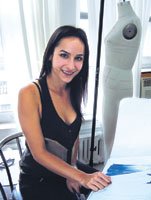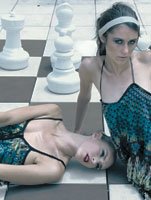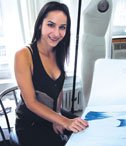Los Angeles is Ground Zero for Natalia Romano
Natalie Hara was 7 years old when the curly haired sprite of a girl first learned to sew. She still has an 8-by-10 color photo of herself wearing a long yellow and orange print dress she created.
Her sewing skills were taught to her by Olga Sotello, who worked with Hara’s father, a lingerie maker. Today, Sotello is Hara’s principal sample maker, helping the young designer create her contemporary line, called Natalia Romano.
The seasoned sample maker is just one of a long string of people in the Los Angeles area who are an integral part in making the 2-year-old collection of dresses, jackets, skirts, tops, pants and shorts a success. There are Los Angeles–based patternmakers, fabric salesmen, cutters and sewing contractors involved in the detailed process, which starts with a drawing on a sketch pad and ends up on a store shelf.
Everything Hara does for her budding collection, geared for the 18- to 40-year-old woman, is made in Los Angeles, except for the fabric. “With all the resources here, why not?” said Hara, who graduated from the Fashion Institute of Design & Merchandising in Los Angeles. “I can get my buttons here. I can get my zippers here. My cutters are across the street.”
There is another reason, too. Hara’s father, Joe Hara, was a Los Angeles lingerie maker for more than a decade. His Lovelace of Hollywood manufactured several labels, including Desireacute;e and Tosca Lingerie, stocked at stores such as Frederick’s of Hollywood. Everything was made in U.S. factories until competition from Mexican and Chinese imports forced him to close his business in 2003. Today, he is the general manager and part owner of the Natalia Romano line, helping his daughter with the back end of the business, which includes domestic production.
“It is really important to me to produce in the United States,” said the designer, who studied with “Project Runway” star Nick Verreos when she was in the Advanced Fashion Program at FIDM, which accepts only 10 students. “No. 1, I don’t support making clothes overseas because you never know the conditions of the workers. Look at Zara and the problems they were having in Brazil with using sweatshop labor. It is not worth it to make something for a few dollars cheaper. I get to see everything done here and develop a relationship with the craftsmen and see my line made every step of the way. hellip; And I always like to support the local economy.”
Setting up shop
Hara launched her line shortly after finishing her studies at FIDM in April 2009. Renting office space in the heart of the downtown L.A. Fashion District, she filled it with two industrial sewing machines, one dress form and two mannequins and started sketching ideas. Soon Natalia Romano—Romano is her grandmother’s last name—was born.
Some star-power visibility revved up the line’s reputation. In 2010, a stylist working with Kendall Jenner, the 15-year-old half-sister of Kim Kardashian, walked into the Mag/net Showroom at the Academy Awards Building in downtown Los Angeles and noticed the Natalia Romano line. She snatched up a black-and-white silk tweed peplum jacket that Jenner ended up wearing for one of her first photo shoots.
Later, a stylist working with “Dancing With the Stars” dancer Karina Smirnoff spotted the line and took some pieces for the celebrity. Smirnoff wore a Natalia Romano beige cotton knit dress with large ruffles around the neckline to the premiere of the Miley Cyrus movie “The Last Song.”
“Immediately after that, the dress sold out in weeks,” Hara remembered.
Hara’s collection encompasses a wide range of looks, from leather jackets that wholesale for up to $550 to silk tank tops that carry a $43 wholesale price tag. One of her signature pieces is a T-strap silk chiffon dress with ruffles that wholesales for $120.
For her Spring/Summer 2012 collection, one of the standout items is a double-faced linen and Tencel skirt ($65) and a double-faced dress ($97) of the same material. A long gray-and-white striped cotton knit dress can be adjusted on the side to raise the hem. A gray-and-white striped cotton jacket has stretch panels in the sleeves to create an elongated, slim look.
Hara, who has hired fellow FIDM student Samantha Hirsch to do her marketing and branding, began showcasing her brand at Project in Las Vegas and later switched to ENK Vegas. Currently, the line is carried in about 30 to 40 stores in areas as far away as Australia and the Dominican Republic.
“Stores love the ’Made in USA’ label,” she said.
For more information about the line, call (213) 891-9455 or visit www.nataliaromano.com.




























